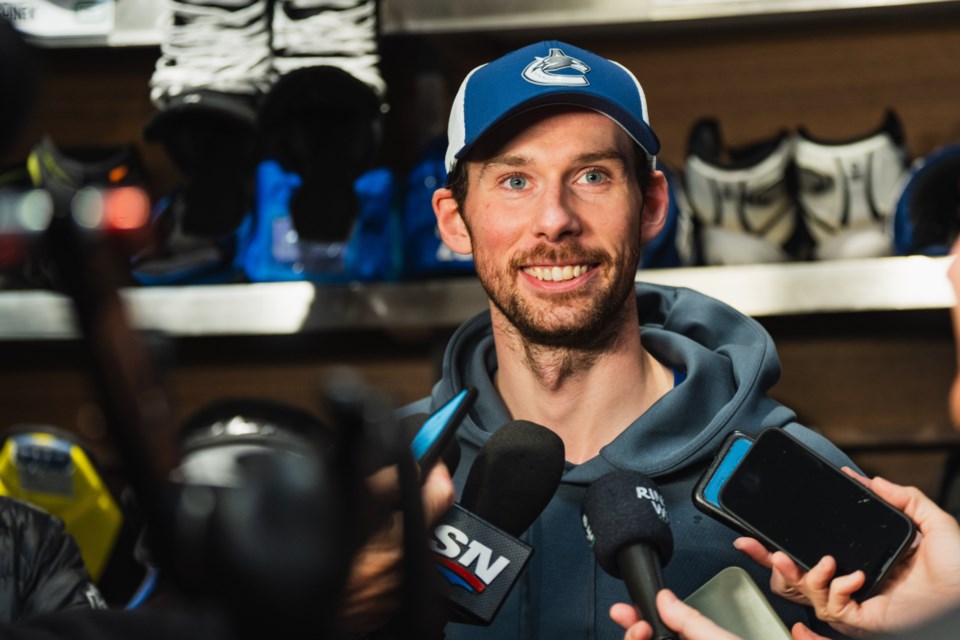Re-signing Marcus Pettersson was always the plan. Getting it done in less than a week shows just how much of a priority it was for the Vancouver Canucks.
The trade for Pettersson echoed the Canucks' trade for Filip Hronek. Both times, the Canucks traded a top-six centre for a package that included a first-round pick and then immediately flipped that pick for what they really wanted: a top-four defenceman.
In both cases, it was a way to get around the fact that they couldn't directly trade for the player they wanted. A player-for-player deal — what is often tautologically called a "hockey trade" — is rare in the NHL. Teams willing to trade top players are typically in a position to be looking toward the future and want future assets in return: prospects and picks. So, general manager Patrik Allvin has turned to making these pseudo-three-team trades.
"My job is to always be ahead of things and communicate with teams around and see what's available," said Allvin. "I had some idea what was needed to get certain deals done and, especially with Pittsburgh, I was aware of what Kyle Dubas was asking for and it worked out that this was the best fit for us."
Pettersson could have been an expensive rental
There are some pretty clear difference between the Hronek and Pettersson trades, however. Hronek still had a year left on his contract; Pettersson is in the last year of his. Hronek was three years younger than Pettersson. And, most importantly, because of their ages, Hronek was a pending restricted free agent and Pettersson was a pending unrestricted free agent.
That introduced some risk into the equation. If Pettersson wanted to, he could have waited until the offseason, become a free agent, and sparked a bidding war across the NHL as one of the top defencemen on the market. With the salary cap going up significantly, there would have been plenty of money exchanging hands this offseason, and Pettersson could have cashed in.
That would have left the Canucks with an expensive rental and, ultimately, very little to show for trading J.T. Miller, one of their best players.
Allvin was well aware of all of this, of course, which is why he moved quickly to get a deal done with Pettersson and sign him to a long-term contract.
"It's definitely a priority for us to get him signed," said Allvin the day after the trade. "I know that Marcus is extremely excited. Jim [Rutherford] mentioned that he traded for him previously and Sergei Gonchar worked with him in Pittsburgh, so there is a lot familiarity with Marcus here."
That familiarity gave the Canucks confidence that they could get Pettersson signed to a new contract in short order. Pettersson was also familiar with the Canucks, which gave him an immediate comfort level stepping into a new room.
"Great group of guys," said Pettersson on his first day in Vancouver. "Met some of them this morning; know a few of them from back home. I'm very excited."
The Canucks, having spent a bunch to get Pettersson, arguably were not in the best bargaining position but clearly Pettersson was happy with the result of the trade and both sides were eager to get a deal done.
The details of Pettersson's new contract
Pettersson re-signed on Wednesday to a six-year contract with a cap hit of $5.5 million per year.
“In just a couple of games, Marcus has already shown us the type of leadership, poise and character that we want in a top four defenceman,” said Allvin in a statement. “He has a calming influence on the ice, uses his long reach and hockey smarts to break up plays and has a good first pass to help us create more offensively. We are extremely happy to get this deal done and look forward to working with him in both the short term and long term.”
Projections from AFP Analytics predicted a five-year deal worth approximately $5.8 million. The Canucks got Pettersson at a lower cap hit but that extra year means it's worth around $4 million more in total.
With the salary cap going up to $95.5 million in the 2025-26 season and further increases in the two subsequent seasons, the Canucks got great value in this deal. Consider it this way: the Canucks signed Tyler Myers at about the same age to a five-year deal worth $6 million back in 2019. That cap hit constituted 7.36% of the salary cap in the first year. Pettersson's constitutes just 5.76% and Pettersson is the better player.
Getting a deal done this quickly, less than a week after the trade, doesn't mean that the contract is a simple one, as there are some complexities that suggest both sides had to make concessions.
Pettersson has a no-movement clause but only through the first three years of the deal, after which it becomes a modified no-trade clause that allows Pettersson to specify 15 teams to which he will not consent to a trade. That gives the Canucks some flexibility in the back half of the deal if they need to move Pettersson but still gives Pettersson some assurances that he can control his destination.
The construction of the deal is also interesting, with $10 million coming in the form of a signing bonus over the last four years of the contract — $2.5 million per year. A signing bonus is generally paid out on July 1 of the contract year, so that would be upfront money prior to the season in question rather than doled out throughout the season, which can have several benefits for a player, especially if they live in a state with a lower income tax rate.
Intriguingly, Pettersson doesn't have a signing bonus in the 2026-27 season; instead, the signing bonuses start in the 2027-28 season. Why that's interesting is because the collective bargaining agreement (CBA) between the NHL and NHLPA expires after the 2025-26 season, so there's a possibility that a lockout could disrupt the 2026-27 season.
Signing bonuses, because they're not salary, are paid out even in case of a lockout or, for that matter, a buyout. If Pettersson had a signing bonus in the 2026-27 season, that would ensure he was paid at least a portion of his contract even if the season was washed out by a lockout.
Avoiding a signing bonus in that season potentially saves Canucks owner Francesco Aquilini a little bit of money if a lockout does occur. Perhaps that was a concession made by the Pettersson camp in exchange for something else.
"Those types of defencemen are hard to get"
Ultimately, the Canucks get what they want: a top-four defenceman to play on the left side behind Quinn Hughes for the next six years. In Allvin's opinion, this was the only way to get a player of Pettersson's caliber.
"In the offseason, there are a lot of things that play into what's available and the cost of it," said Allvin. "We always had our sight towards potentially finding a top-four defenceman. The cost and what was available this summer, we couldn't get what we wanted, and therefore we constructed the roster as we did."
The key in Allvin's mind was getting Pettersson without losing any of the prospects they felt were close to making the NHL.
"Marcus was a key piece for us," said Allvin. "We've been looking since the summer and those types of defencemen are hard to get. There wasn't a whole lot available on the market and a lot of teams asked for our young players."
Pettersson is a legitimate top-four defenceman, bordering on a top-pairing defenceman. There's little not to like in this deal.




